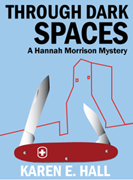by Karen Hall
Where to set your novel. It’s one of the first questions you must answer when you begin to write. Will it be a familiar place? San Francisco, maybe? Even if she’s never been there herself, your reader will have a pretty good idea of how things look; she’s probably seen dozens of movies set there. Or New York. Same thing. But what if your setting is unusual? Foreign, maybe? Or in part of the country that’s rarely visited?
My second mystery, Through Dark Spaces, is set in a deep, hard rock gold mine — lots of new terminology and a setting unfamiliar to nearly everybody. But what a place for a murder!
Although the entire novel doesn’t take place underground – how boring would that be? – I knew I wanted the climax to happen there. My protagonist, a 30-year-old environmental engineer named Hannah Morrison, would not only have to face her latent claustrophobia, but she would be totally out of her element. That would force her to think on the fly, make life or death decisions with little understanding of their consequences. She does, of course, measure up to the job.
Over the course of writing several drafts of this book, I learned quite a lot about unusual settings, and have developed my own list of Do’s and Don’ts.
Don’t:
Set the climax of your story in a place the reader hasn’t “seen” before. This is a cardinal rule of mystery writing – of any writing, actually – and if you break it, you’re asking for trouble. You’ll have to stop the action to introduce the reader to the new place and define new terminology. That will slow your action and irritate your reader, especially if your setting, like mine, isn’t just a new place but a new world.
Use only place names in describing your setting. If your book is set in Turkey, street names, even city names, simply won’t help. Most of us have never been to Turkey, and the unfamiliar place names will only irritate the reader – unless they’re accompanied by great sensory description.
Do:
Introduce an unusual setting early in your novel. If the climax of your book takes place in the cargo hold of an airplane or at the top of a minaret in Baghdad, take your reader there early so that when you get to the end, she’ll already “see” where your protagonist is struggling. The action can then proceed quickly and without interruption.
Introduce new terminology early, too. Ever heard of a cage or a crosscut? A winze or a stope? They’re mining terms, and every one of them is necessary to the conclusion of Through Dark Spaces. I took care to make sure the reader understands them well before the ending.
Include a map and a glossary. Though your publisher might balk at the extra pages, they’re well worth it for an unusual setting. Baghdad? No problem. Helsinki? Okay, got this. My setting, the Aureus Mine? More difficult, but also a possibility.
Make your reader comfortable with this odd place. Once your reader has been introduced to the place and its terminology, her understanding will be reinforced when characters discuss it. She’ll smile as she reads, thinking, “I know what they’re talking about here!” She’ll be able to visualize it. So be sure that your reader will remember those details. Slip them in several times in the course of the book so that when you get to the critical passages, she’ll follow without aid of a dictionary.
Add Lots of Sensory Detail:
At a writer’s conference several years ago, I went to a presentation on developing setting. While I’d heard most of it before, I did pick up one really great tip that helped me – and will help you — develop a great sense of setting, especially for an unusual place. Find five different colored markers and print out your manuscript. Label each marker for one of the senses: taste, touch, sight, sound and smell. Read through your manuscript and as you do, highlight every time there’s a sensory detail. You’ll be surprised, I think. I know I was. My manuscript was mostly blue, the color I’d chosen for sight. The trick: try for one of each color on every page. While taste might not be appropriate in every scene, definitely try for all the rest. This visual tool will help you understand where you can add those delicious details, that all-important sensory input that will draw your reader into the setting.
Here’s a short passage from the beginning of Through Dark Spaces. Check out the sensory detail – and the new terminology, “cage.”. Can you “see” the setting? I hope so!
“Here we go,” the trainer said.
Packed like crayons in a box, the miners jostled and poked each other, trading insults and ignoring the trainees, until the cable began to roll over the monster flywheel and the cage dropped, jostling between the steel-reinforced walls, feeling almost like freefall, down the Cheyenne and into the mine.
Hannah clamped her jaw as the cage fell, felt the pulse hammer in her throat. They passed lighted levels—every 150 feet, the trainer had said—but they flashed by so quickly Hannah could only count them. The cage bounced against its guards, jarring them, banging, eliminating the possibility of talk. She tried to brace herself, but there was nothing to hold onto. No railings, no walls, just metal slats. A freight elevator falling into the center of the earth.
A phrase from church flashed into her mind: He descended into Hell. Was this a reasonable facsimile? The farther they dropped the hotter it got, reinforcing the thought. Gooseflesh rose on her scalp and she felt like screaming.
Please, God, let this be over soon.
If you follow these “rules,” your readers will love you – and your sales will show it!
















0 Comments